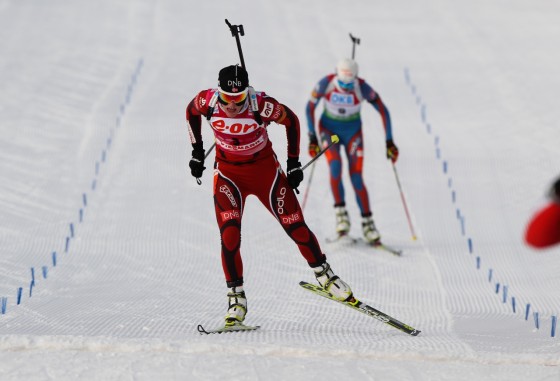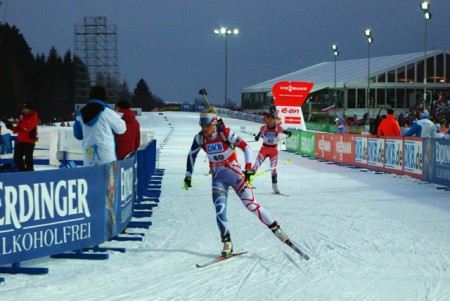
Over the course of a four-stage race, it’s not common for biathletes to hit all 20 targets.
That’s four trips to the range, four individual bouts where something could go wrong and the wind could come up.
Four times when the athlete hopes that their legs don’t get shaky, their arms aren’t tired, their brains aren’t too deprived of oxygen to shoot straight.
Four instances of mind of matter, when they have to block out the crowds and the other competitors.
Usually, a couple athletes do clean all their targets – maybe two, maybe three. In the top ten, racers might have one, two, or may three penalties, skiing an extra hundred and fifty meters for each missed shot.
But to have a winner with four penalties? It has happened, for sure, but not so often. And to have the top ten full of skiers with six, seven, or even nine penalties? Now that is something else.
In today’s 10 k World Cup pursuit in Oslo, the wind played tricks on the field and nobody cleaned. After just a single shooting stage, tenth place was already almost two minutes behind the leader, and much of the field had racked up in one go as many missed shots as they usually do in an entire race.
A few competitors, so exasperated after missing three or four shots in each of the first two stages, simply dropped out.
When asked about the race, third-place finisher Anastasiya Kuzmina of Slovakia was completely honest.
“I don’t know about fun,” she said. “I think it was very hard work for everybody.”
“It was like a party in the penalty lap,” American Annelies Cook told FasterSkier.
There seemed to be two strategies for dealing with the wind. One was to try to shoot quickly, get it over with, and do the penalty loops if necessary. That’s the route that Tora Berger of Norway took, and it payed off – she started with just a 12-second lead after winning the sprint, but extended it to 31 seconds by the finish despite her four penalties, and only gave up the lead once.

Berger has had perfect four-stage races earlier this season, but today was not destined to be one of them.
“There was a lot of wind today, and it was not so easy to shoot,” she said at the post-race press conference, understating things as usual. “I tried to do the best. On the first shooting it was not so much wind, but then on the last two it was really difficult.”
Berger had the fastest shooting time in the field, which, she admitted, cost her.
“On the last shots, I think it was too fast,” she said, before laughing: “I thought I had control, but I didn’t!”
The other strategy was to wait, patiently, for the wind to offer up a split-second of reprieve when it was possible to get a clean shot off. The reward might be fewer penalty loops; the risk was that even after waiting, sometimes the targets wouldn’t go down.
But for Marie Dorin Habert of France, they did. She collected just two penalties over the course of the race, and finished 31 seconds back from Berger to tie the best result of her career. She spent 35 more seconds on the range, more than her finishing deficit to Berger, but clearly didn’t regret it – she savored the moment as she crossed the finish line, waving big to the crowd for a full hundred meters and grinning as if she had won outright.
“I think I am a very, very, very lucky woman today, and I am very happy,” Dorin Habert said in the press conference. “I am always just around the podium so this is truly a good performance for me…. I am not a star, so it feels very nice to be here.”
Dorin Habert had at one point led Berger, leaving the range for the third time when she had accumulated just one penalty to Berger’s three. But the Norwegian didn’t waste time in catching her on the tracks.
Both had a single penalty in the final stage, and Dorin Habert embarked on her final loop just seven seconds behind the Norwegian. She was safe in second, but couldn’t touch first, bogging down and bleeding time to Berger.
Behind her, Kuzmina was making a steady comeback after dropping from third, her start position, to fourth after the first stage. She moved quickly back into third, but could never edge much closer to the leaders – until the end, when Dorin Habert slowed down.
“The snow was softer today, and also the wind was very strong,” Kuzmina said. “Sometimes it stopped me. I’m tall, and so it wasn’t easy to ski fast.”
Krystyna Palka of Poland tied Dorin Habert’s good shooting, and moved from 16th place after the sprint into fourth – over a minute and a half behind Berger. Another 45 seconds later, Darya Domracheva crossed the line in fifth. She had started in second position, but picked up nine penalties over the course of the race. That meant skiing 1350 meters in penalty loops, but she still had the fastest course time.
But the day clearly belonged to Berger, who took her tenth win of the season, the 26th of her career, and her 50th podium. In the past few weeks she has passed Norwegian great Liv Grete Poirée, now a commentator for NRK television, in the record books.
“There are almost no words to describe this girl,” Poirée said after today’s race.
* * *
North Americans struggled no less on the range than anyone else. Zina Kocher of Canada led the way, moving from 42nd up to 28th despite six penalties. Teammate Megan Heinicke had seven, and jumped from 51st to 42nd.
Cook, the lone American qualified from the sprint, racked up nine penalties, but still managed to climb from 46th to 38th.
“I was pretty surprised to make points with that many penalties, but I guess I caught just enough girls on the ski tracks to make it!” she wrote in an e-mail to FasterSkier.
The toughest thing about the wind, Cook said, was that it wasn’t consistent – it wasn’t even always coming from the same direction. That meant that making corrections quickly became a nightmare.
“In the first prone it was blowing really hard one way and I took clicks like we talked about in zeroing,” she explained. “Then the wind changed and I started to get confused about what to do, and I took clicks again and kept on missing… and what was worse, I had no idea where I was for the next prone because my shots had no pattern, so I just kind of had to make a guess and stick with it.”
The wind wasn’t only blowing her bullets around: Cook described her body “getting blown back and forth” in standing. On the broadcast, competitors’ hair, clothes, and bibs could be seen dancing in the wind, and the long-range cameras couldn’t hold steady on some of their shots.
With the field spreading out so much, Cook knew she was in danger of getting lapped, which would mean getting pulled from the race. She was especially worried because the sprint was, she said, her worst race of the year for skiing, and for most of her warm-up she still felt terrible. That wouldn’t have helped if she had needed to outsprint the leader.
“Turns out, I felt really good in the race, had awesome skis and had a really good ski day which was necessary because Tora Berger was coming up in my fourth lap and I knew I had to make it into the shooting range before she passed me!” Cook wrote. “I was skiing around the penalty loop and I could hear her shooting and the fans cheering when she hit her targets. It was like %($$)(% and then I heard she had a miss, so I thought it might be my chance to make it.”
Chelsea Little
Chelsea Little is FasterSkier's Editor-At-Large. A former racer at Ford Sayre, Dartmouth College and the Craftsbury Green Racing Project, she is a PhD candidate in aquatic ecology in the @Altermatt_lab at Eawag, the Swiss Federal Institute of Aquatic Science and Technology in Zurich, Switzerland. You can follow her on twitter @ChelskiLittle.



